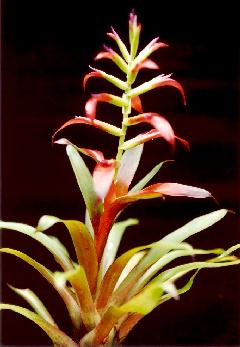
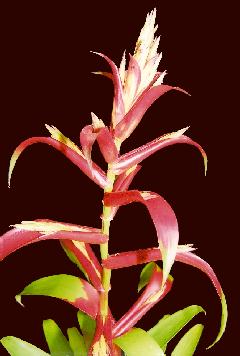
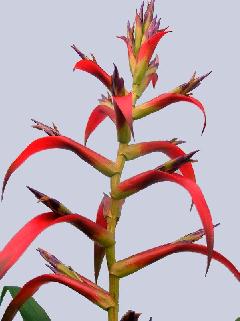
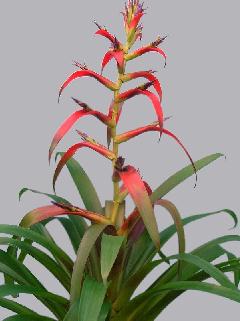
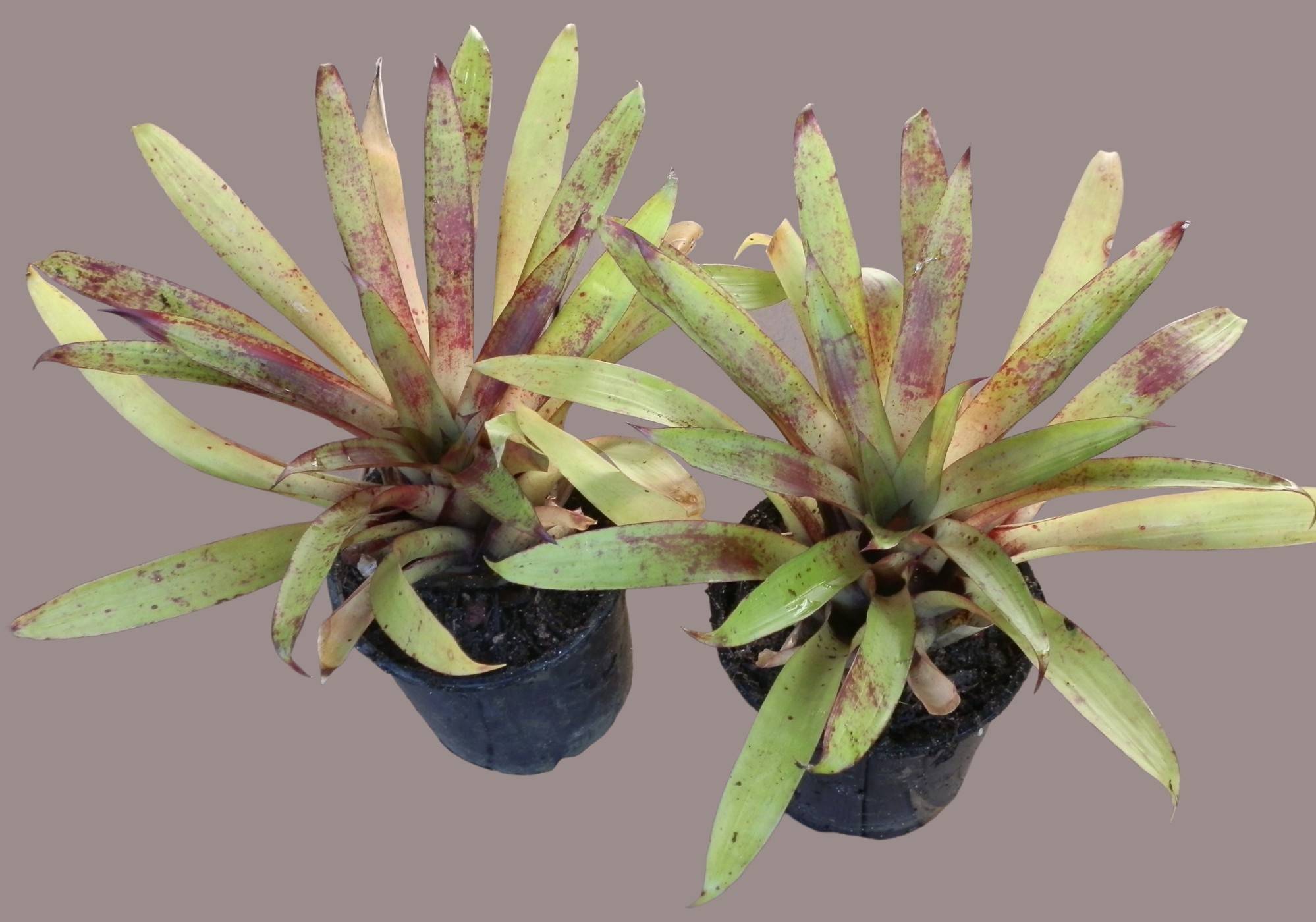
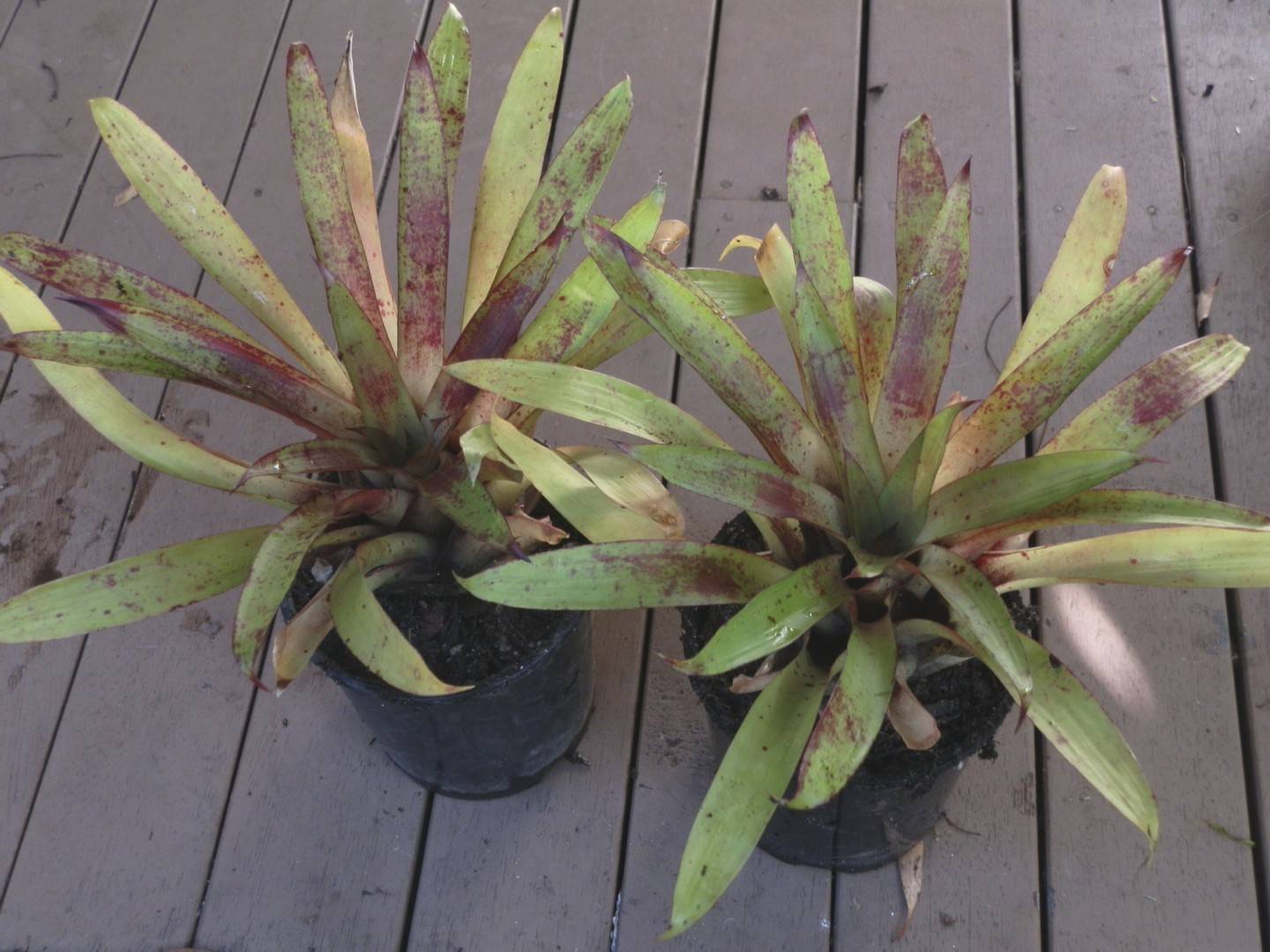

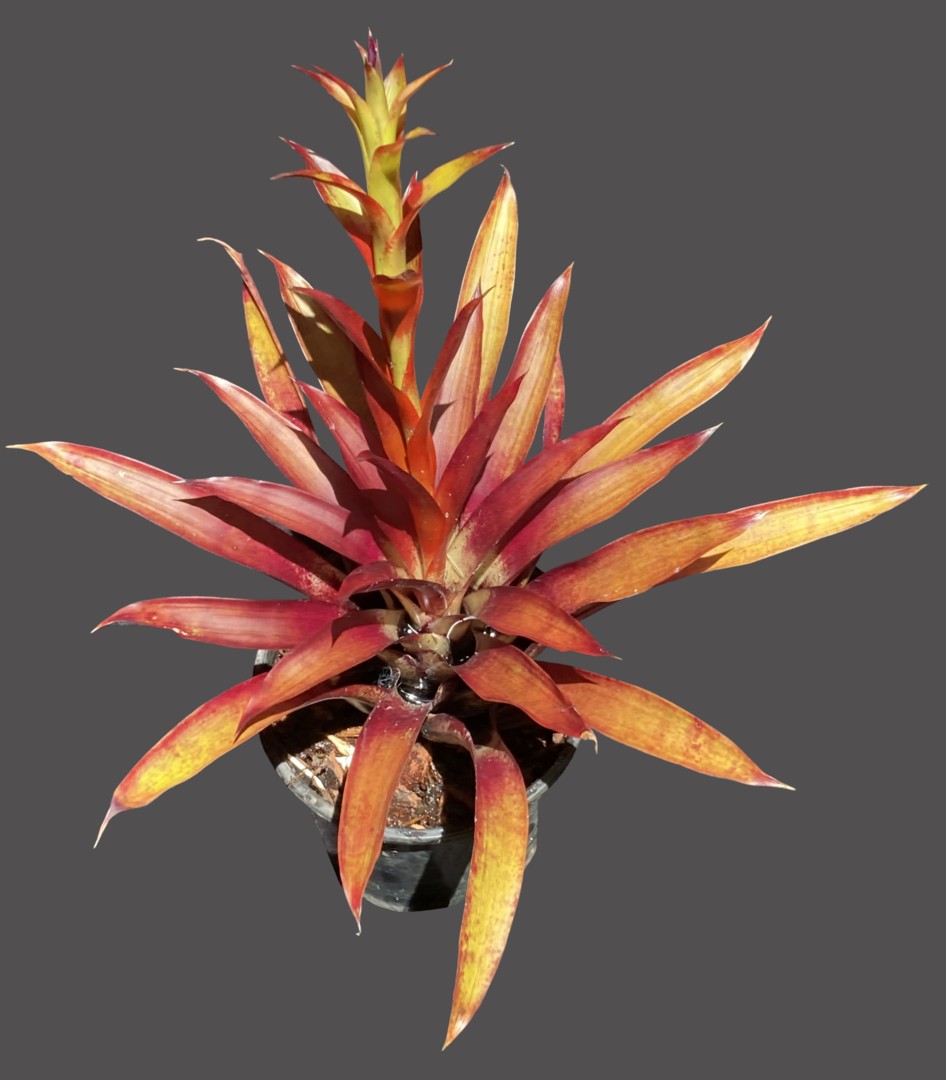
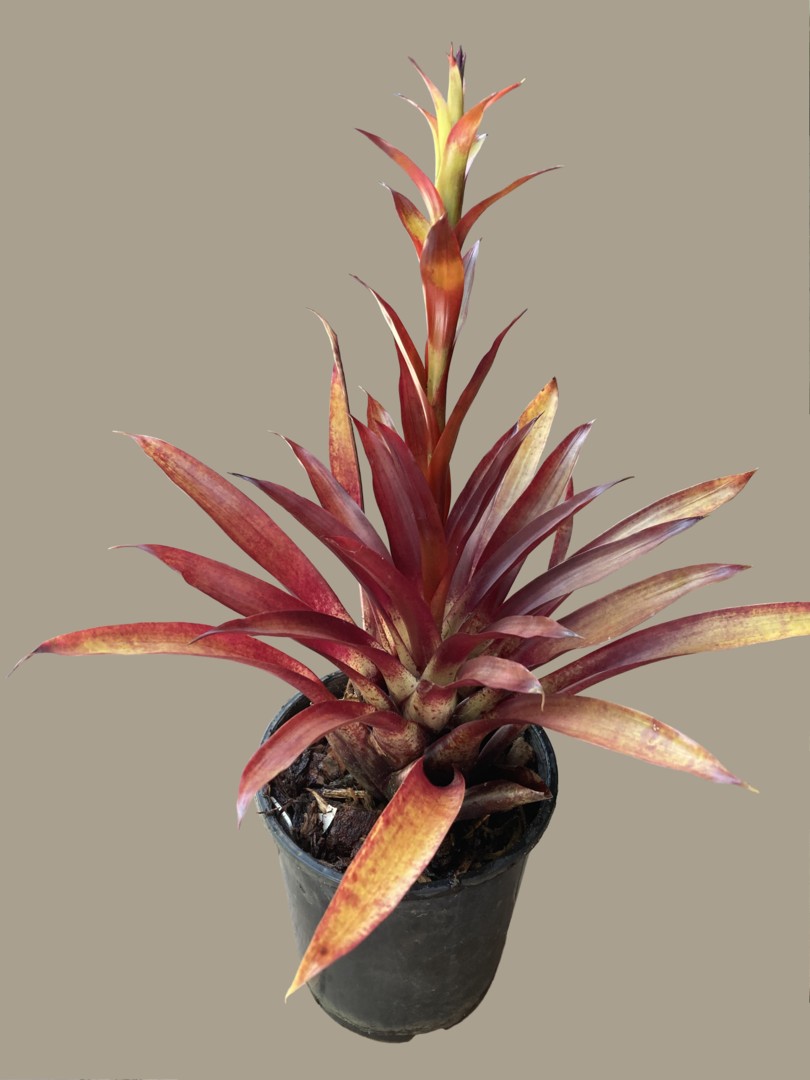
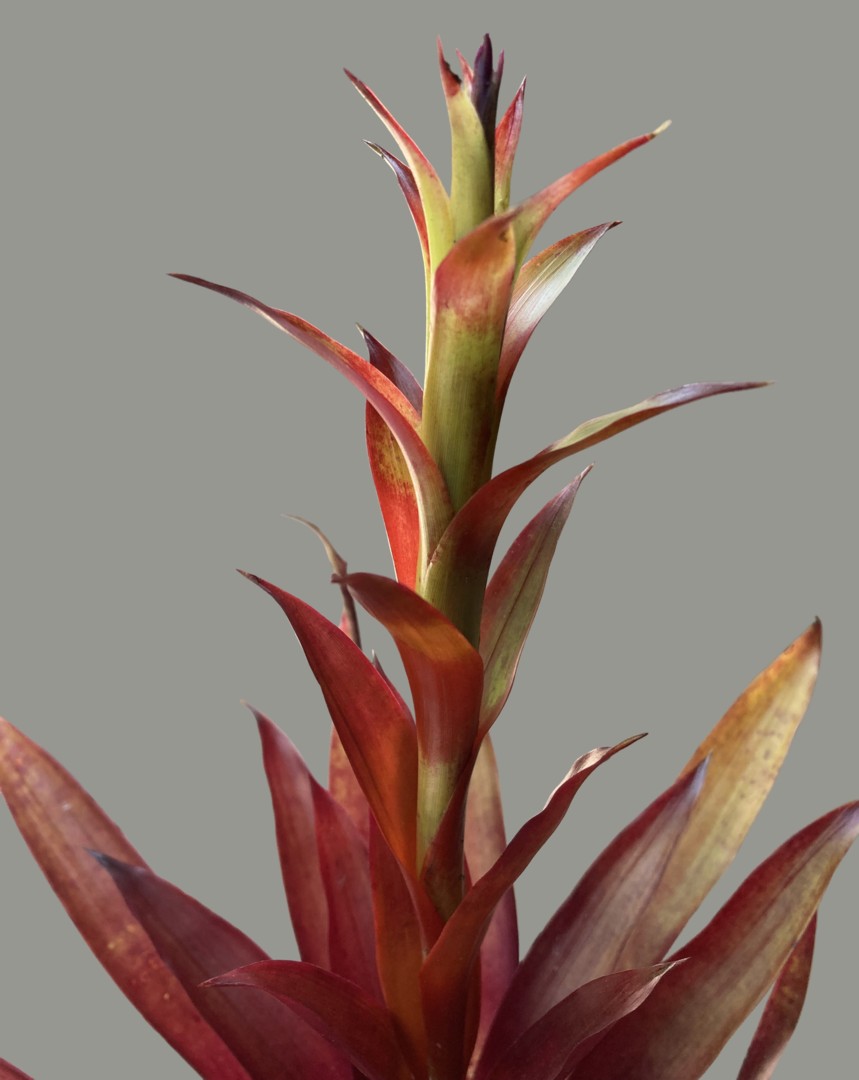
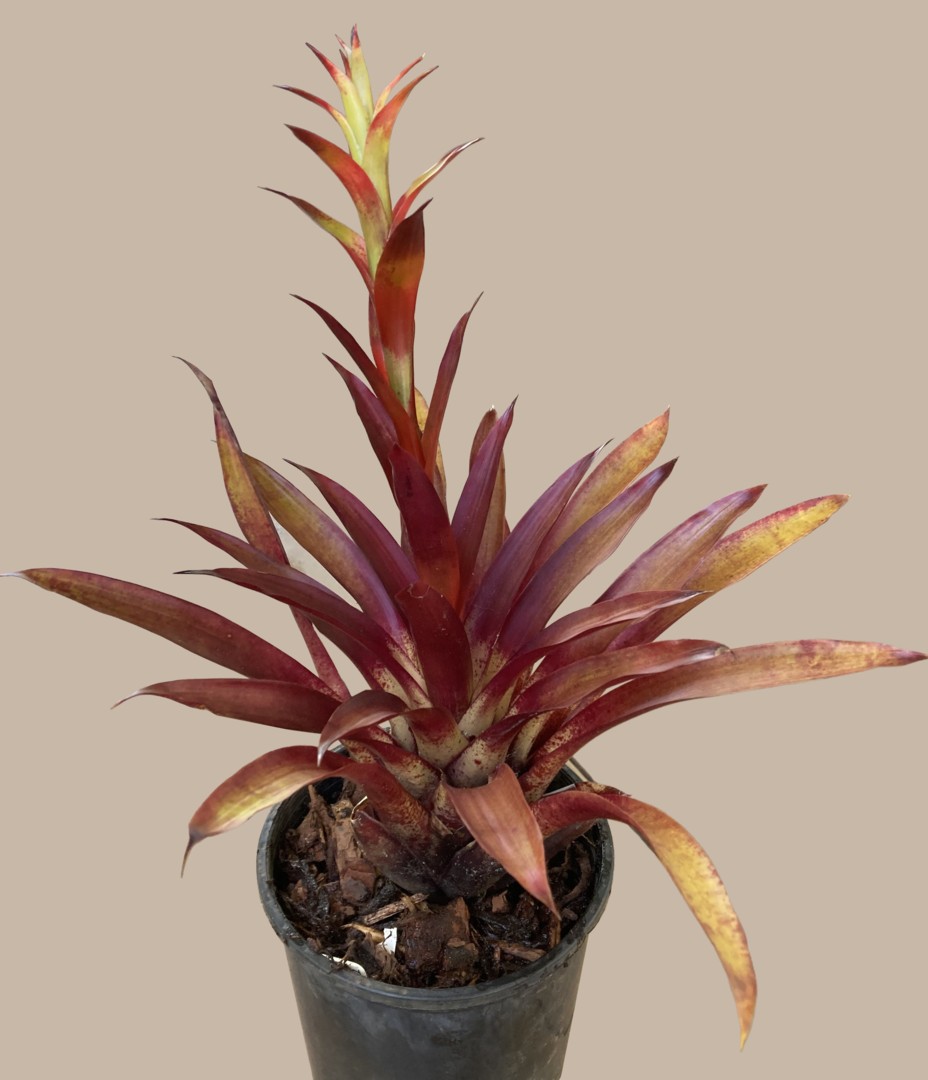
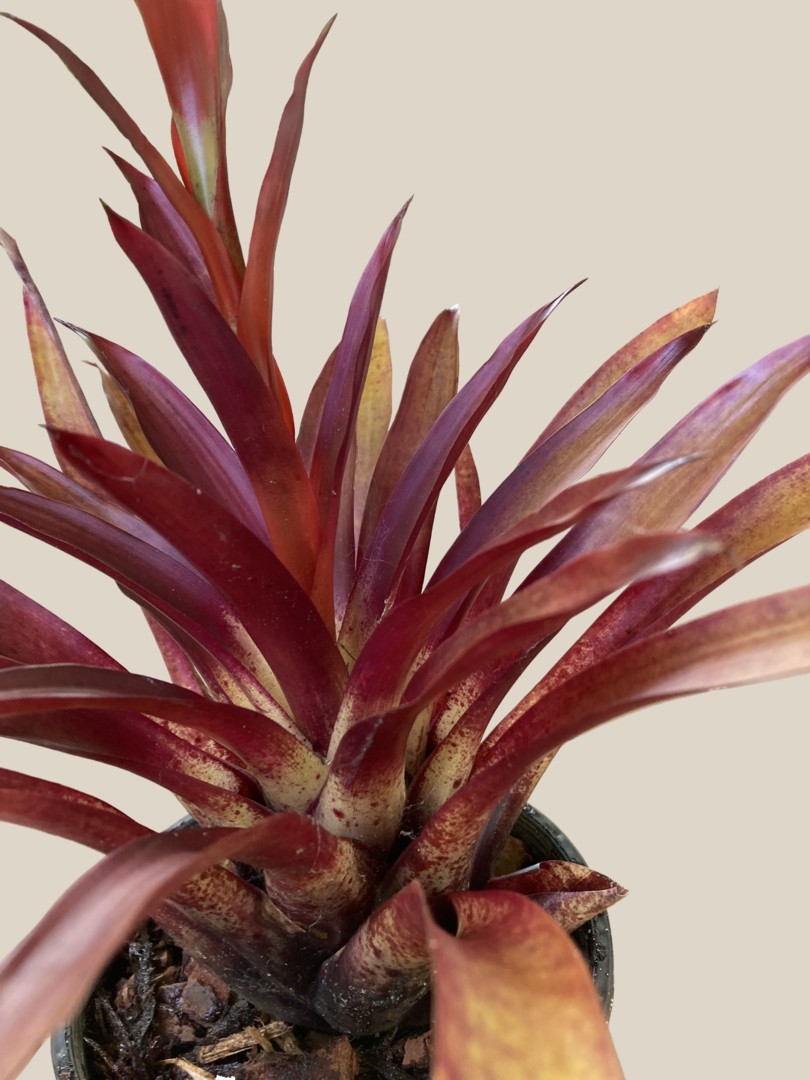
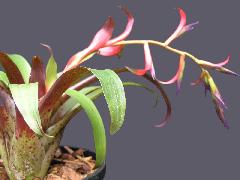
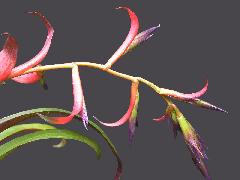
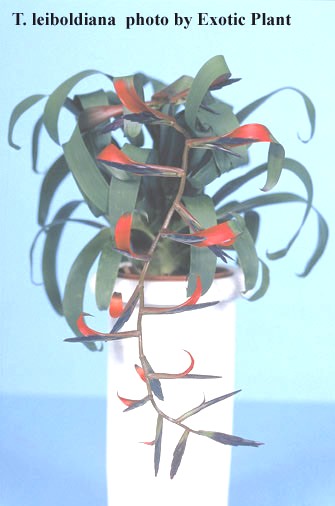
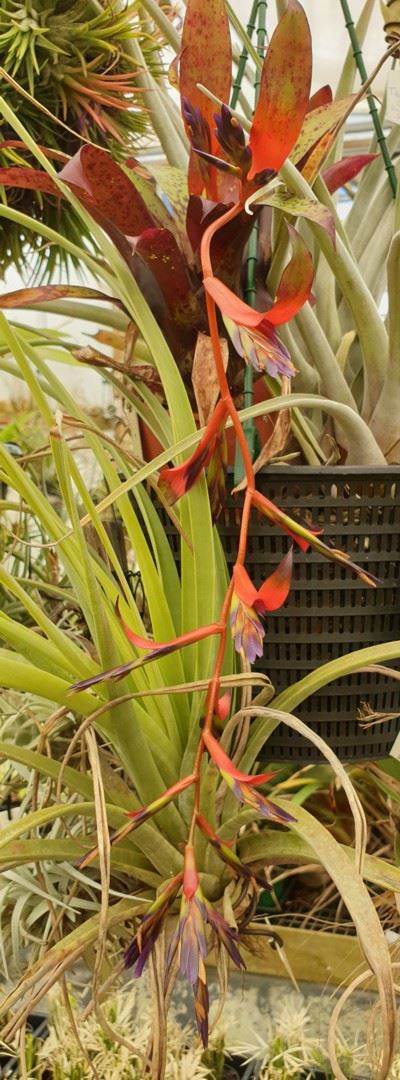
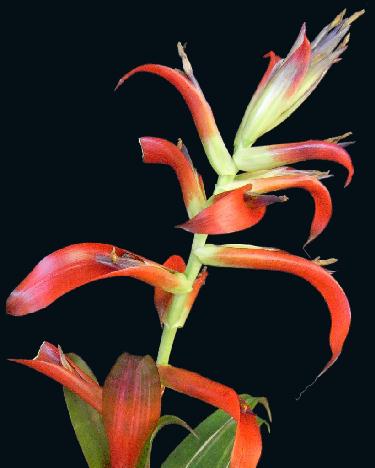
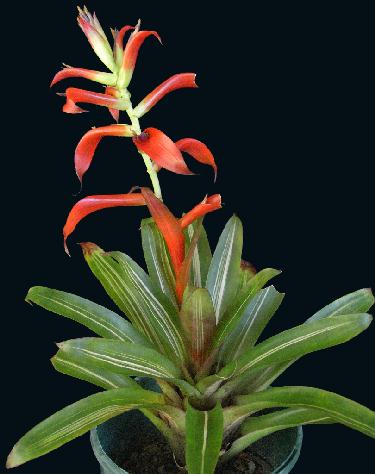
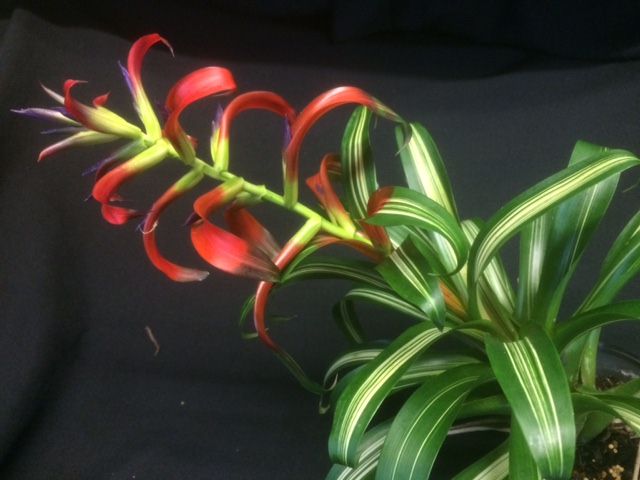
Desc from S&D p747-9
Plant stemless, flowering 2-6 dm high.
Leaves many in a crateriform rosette, 1-3 dm long; concolourous green or spotted.
Sheaths ovate, 6-8 cm long, flat, brown-punctulate-lepidote;
Blades ligulate, acute, flat, to 25 mm wide, very obscurely pale-lepidote.
Scape erect or rarely curved, slender , glabrous;
Scape-bracts erect, densely imbricate, large, foliaceous but the upper ones with bright red bases.
Inflorescence compound with simple branches or tripinnate at base, laxly pyramidal or sub cylindric, 1-3 dm long; axis slender, glabrous;
Primary bracts like the upper scape-bracts, all but the uppermost much exceeding and closely enfolding the axillary spikes, obscurely lepidote toward the apex, the upper ones wholly bright red;
Spikes sessile, divergent to spreading, linear to lanceolate, acute, complanate, densely 3-7-flowered, 3-6 cm long; rhachis straight, slender, angled, glabrous.
Floral bracts erect, imbricate, narrowly ovate, acute, 2 cm long, exceeding the sepals, 4 times as long as the internodes and usually concealing the rhachis, subcoriaceous to chartaceous, prominently nerved, carinate and often dark purple toward apex, glabrous outside, punctulate inside;
Flowers subsessile.
Sepals lance-oblong, to 16 mm long, thin, glabrous, the posterior carinate, short-connate to wholly united;
Petals linear, to 3 cm long, violet;
Stamens included.
Capsules slenderly cylindric, acute, about equaling the floral bracts.
Type. Leibold 180 (holotype B, B photo 1192/9), without exact locality, Mexico.
DISTRIBUTION. Epiphytic in forest, 25-2000m alt, southern Mexico, Central America. MEXICO. VERA CRUZ: Orizaba, Bourgeau s n (G); May 1905, Purpus s n (UC); Huatusco, Ghiesbreght 79 (P); May 1935, Foster s n cult. Aug 1943 (GH); Jalapa, Galeolti 4915 (P); Valley of Cordoba, Bourgeau 1772 (P); Paso del Correo, Liebmann Brom.-19 (C); Mirador, Liebmann Brom.-20 (C); Zacuapan, Aug 1906, Puryus 2102 (F, GH, MO, NY, UC); 1914, 7392 (F, GH, MO, NY, UC); Sep 1936, 16799 (US); La Sierra de Lombardia, Ejido de Pueblo Nuevo, Aug 1943, Santos 2331 (MICH); Fortin to Jalapa, 15 Apr 1957, Foster & Van Hyning 3008 (US); Cascada de Texolo, Jalapa, 19 Jun 1961, Paray 3172 (IPMEX). PUEBLA: Huachinango, 6 May 1954, Matuda 32214 (US). OAXACA: San Antonio Eloxochitlan, 25 Jul 1938, Schultes & Reko 415 (GH). CHIAPAS: Laguna Ocotal Grande, Ocosingo, 14 Apr 1967, Breedlove 15698 (DS). GUATEMALA. ALTA VERAPAZ: Coban, Oct 1907, Tuerckheim II-2017 (US); Chirriacte, 9 Apr 1941, Standley 91949 (F, GH); 91959 (F). IZABAL: Rio Dulce, Livingston, 14 Apr 1940, Steyermark 39372 (F). BRITISH HONDURAS. Camp 34, British Honduras-Guatemala survey, 10 Apr 1934, Schipp S-810 (GH, MICH); Union Camp, Columbia, 13 Mar 1948, Gentle 6468 (LL). HONDURAS. COMAYAGUA: Siguatepeque, 17 Ju1 1936, Yuncker, Dawson & Youse 5932 (GH); 5933 (GH); 11 Aug 1962, Kimnach 396 (UC). NICARAGUA. MATAGALPA: Santa Maria de Ostuma, Heller 5627 (F); Matagalpa to El Tuma, Jan 1963, Williams et al 24042 (F). JINOTEGA: Jinotega, Grant 7309 (GH). COSTA RICA. GUANACASTE: Aguacaliente, 10 Feb 1922, Greenman 5535 (MO); .Tilaran, Jan 1926, Standley 44809 (US); 44813 (US); 44858 (US); 45645 (US); 46326 (US); El Arenal, Jan 1926, Standley 45299 (US); 45321 (US). PUNTARENAS: San Vito de Java, 18 Aug 1967, Raven 21926 (F, US). ALAJUELA: San Ramon, May 1913, Tonduz in Inst. Costar. 17894 (US); San Pedro de San Ramon, 13 May 1923, Brenes 3890 (F); 17 Oct 1925, 4543 (F); 23 Ju1 1932, 16170-A (NY); 16173 (F); Zarcero, A. Smith A-276 (F). LIMON: Rio Reventazon, Cairo, Feb 1926, Standley & Valerio 48947 (US). HEREDIA: Rio Puerto Viejo, Jan 1967, Burger & Malta 4221 (F, US). SAN JosE: Zurqui, 13 Feb 1926, Standley & Valerio 48315 (US). CARTAGO: Cartago, 1901, Werckle in Inst. Costar. 16209 (G); Volcan Irazu, San Rafael, Dec 1894, Pittier in Inst. Costar. 9106 (US); Peralta, Ju1 1923, Stork 519 (US); Cerro de La Carpintera, Feb 1924, Standley 34288 (US); Finca Las Concavas, Dec 1925, Standley 41449 (US); Pejivalle, Feb 1926, Standley & Valerio 46766 (US); 47230 (US); Rio Reventado, Cartago, 26 Feb 1926, Standley & Valerio 49506 (US); 49606 (US); El Mufleco, Rio Navarro, Mar 1926, Standley & Torres 51396 (US); 51751 (US); Agua Caliente to Cartago, 12 Mar 1930, Dodge & Thomas 7142 (GH); 7153 (GH); Rio Reventazon, Santiago, 22 May 1930, Dodge 7867 (GH); Turrialba, 17 Jun 1932, Kupper 1603 (M); 17 Ju11947, DeWolf 346 (US); 19 Jun 1949, Holm & Iltis 13 (US); 21 Ju1 1962, Haines & Haines 738 (US); Paraiso, 19 Jan 1932, Kupper 421 (M); 422 (M); Tapanti, 6 Ju11936, Valerio 1438 (F); 14 May 1967, Lent 967 (US). PANAMA. VERAGUAS: Santa Fe, Cerro Tute, 25 Mar 1947, Allen 4360 (MO).
Tillandsia leiboldiana var guttata M. H. Hobbs, Bromel. Soc. Bull. 11: 42.1961. NOW TREATED AS T. leiboldiana See DeRebus I 1994, p29
Tillandsia aschersoniana Wittmack, Bot. Jahrb. I I: 68. 1889. Type. Turrialba, Cartago, Costa Rica, Lehmann 1810 (G, US photo), 16 Jan 1882.
Tillandsia rhodochlamys Baker, Handb. Bromel. 203. 1889. Type. Without exact locality, Mexico, Morren Icon from Pfau 255 (K).
Tillandsia sparsiflora Baker, Jour. Bot. London 28: 306.1890. Type. Serraquitche, Alta Verapaz, Guatemala, J. D. Smith 1659 (US).
Leaf-blades red-spotted especially at base.
TYPE. M. H. Hobbs s n (holotype US), Orosi, Cartago, Costa Rica, 16 Feb 1961. DISTRIBUTION. Epiphytic in forest, 500-1500 m alt, southern Mexico, Central America.
MEXICO. CHIAPAS, Ocosingo: Laguna Ocotal Grande, 1954, Dressler 1466 (US). GUATEMALA. ALTA VERAPAZ: Finca Sepacuite, 4 Apr 1902, Cook & Griggs 419 (US). IZABAL: Exmibal, Lake Izabal, 6 May 1966,
ones & Facey 3269 (US). COSTA RICA. PUNTARENAS: San Jeronimo, Mar 1909, Biolley in Inst. Costar. 17360 (US). SAN JOSE: San Jose, 1899, Werckle s n, cult. Rose 3785 (US); Lankester Finca, 18 Dec 1948, Foster 2706 (US). CARTAGO: Cartago, Jan 1887, Cooper 257 (US); Cooper in J. D. Smith 5956 (US); Feb 1924, Standley 33320 (US); 33332 (US); 33396 (US); Talamanca Mountains, south of Cartago, 29 .Jul 1962, Haines 752 (US).
Detail from Baker 1889 now treated as synonyms of T. leiboldiana
198. T. RHODOCHLAMYS Baker (M.D.).
Leaves lanceolate, densely rosulate, 6-8 in. long, under an inch broad at the middle, thin, flexible, subglabrous, pale green, copiously spotted, especially in the lower half, with blotches of claret-brown.
Peduncle as long as the leaves;
upper bracts small, crowded, ovate, erect, spotted like the leaves.
Inflorescence a panicle 2-3 in. long;
branch bracts lanceolate, bright red, the lowest 10.5-2 in. long;
spikes dense, simple, sessile, the lowest 10.5 in. long;
flower-bracts oblong-lanceolate, ⅝-0.75 in. long.
Calyx shorter than the bract.
Hab. Mexico, Pfau 255. Described from Prof. Morren's drawing, made in 1883. Near T. xiphophylla.
199. T. ASCHERSONIANA Wittm. in Engl. Jahrb, xi. 68.
Leaves about 16 in a rosette, lorate from an ovate base, 6-9 in. long, nearly an inch broad at the middle, thin, pale green, deltoid-cuspidate at the tip.
Peduncle as long as the leaves.
Panicle nearly a foot long, consisting of 10-12 dense simple subseasile spikes 1-2 in. long, under 0.5 in. broad;
branch-bracts oblong-lanceolate, lower longer than the spikes;
flower-bracts oblong-lanceolate, dark red, nearly an inch long.
Calyx much shorter than the bracts.
Petals violet.
Hab. Costa Rica, alt. 2500 ft., Lehmann 1810. Near. T. xiphophylla.
202. T. XIPHOPHYLLA Baker in Journ. Bot. 1888, 143 (M.D.).
Leaves about 20, densely rosulate, lanceolate from an ovate base, a foot long, under an inch broad at the middle, bright green, thin, flexible, subglabrous.
Peduncle shorter than the leaves, quite hidden by the large lanceolate bract-leaves.
Panicle lax, non-distichous, 4-6 in. long;
branch-bracts ovate, bright red, the lower 2-3 in. long;
spikes short, dense, distichous, erecto-patent;
flower bracts oblong-lanceolate, 0.75-1 in. long.
Calyx 0.5 in. long;
sepals oblong, obtuse. Petals dark lilac, convolute in the cylindrical tube. an inch longer than the calyx.
Capsule an inch long.
Hab. Mexico; valley of Cordova, Bourgeau 1906! Drawn by professor Morren from a plant flowered in 1881. Allied to T. Lieboldiana, but quite different in leaf.
208. T. PHYLLOSTACHYA Baker in Journ. Bot. 1888, 148.
Leaves about 20, densely rosulate, lanceolate-acuminate from an ovate base above an inch broad, a foot long, 1/2 to 1/3 in. broad at the middle, moderately firm in texture, subglabrous.
Pedunole rather shorter than the leaves, quite hidden by the large lanceolate bract-leaves.
Panicle multifarious, 3-4 in. long; branch-bracts ovate-lanceolate, recurved, the lower 3 in. long;
spikes dense, few-flowered;
flower bracts ovate, acute, 0.3 in. long.
Calyx 0.5 in. long;
sepals oblong.
Petal-blade violet, as long as the calyx.
Hab. Central Mexico, Hahn ! Gathered during the French Expedition of 1865-6.
Detail from Mez 1935 now treated as synonym of T. leiboldiana
278. T. lilacina Mez in DC. Monogr. Phaner. IX. (1896) 806.
Ad 0,2 m alta. Folia subutriculatim rosulata, ad 0,12 m longa et 10 mm lata, membranacea, linearia, peracuta, subglabra. Scapus gracilis, erectus, foliis multo brevior, dense vaginis omnino foliaceis erectis indutus: Inflorescentia pauciflora, laxa, complanata, 2-pinnatim panniculata, ad 90 mm longa et 60 mm diam. metiens; bracteis primariis caeruleo-lilacinis, e lineari longe peracutis, spicas axillares inferiores saltem longe superantibus; spicis flabellatis, perangustis sublinearibus, 2-4-floris, subsessilibus, rhachi distiche insertis, suberectis vel suberecto-patentibus, vix ultra 30 mm longis, 5 mm latis; bracteis florigeris imbricatis, lineari-ovalibus, apice angustissime acuminulatis, valde prominenti-venosis, membranaceis, ad 17 mm longis, sepala multo superantibus. Flores stricte erecti, 22 mm longi ; sepalis membranaceo-chartaceis, antico libero, posticis ad 2 mm connatis, tenuissime prominenti-venosis, lanceolatis, acutiusculis, 11 mm longis. Petala tubulose erecta, sepalis duplo longiora, genitalia superantia.
Nicaragua: Dept. Matagalpa, bei Canada Yasica (Rothschuh n. 112).
36. T. Aschersoniana Wittm. n. sp., Bot. Jahrb. II: 68. 1889.
foliis rosulatis, brevibus, lanceolato-lingulatis, basi dilatatis, apice cuspidatis, planis, tenuibus; scapo foliis aequilongo, sed cum panicula foliis plus dupla longiore, anaphyllis foliiformibus, oblonga-lanceolatis, magnis obtecto; panicula spiciformi, e circ. 12 spicis remotis, subsessilibus quaquaversis composita; anaphyllis fertilibus (bracteis ramorum) oblongo-lanceolatis, cuspidatis, inferioribus spicas superantibus, usque ad medium involutis et spicas fere omnino involventibus, superioribus spicis aequilongis; spicis brevibus, subangustis, 4-5 floris, dense distichis, inferioribus et superioribus subadscendentibus, mediis horizontaliter patentibus, bracteis floralibus lanceolatis, acutis; sepalis lineari-lanceolatis, bracteis fere duplo brevioribus; petalis bracteae subaequantibus, ungue lineari, tenui, lamina anguste oblonga; staminibus petalis brevioribus, stylo cum stigmatibus tortis petalis subaequilongo, ovulis longe funiculatis et apiculatis.
Planta dimensione media; folia circ. 14-15; 22 cm longs, ad vaginam 5-6 cm longam 2,5, medio 2 cm late, "flavo-viridia". Scapus ad 18, panicula ad 25 cm longa, 10 cm late. Anaphylla fertilia 2-1cm inter se remota, inferiora ad 7 cm longa, 1.3 - 1.5 cm lata, superiore 3 - 3.5 cm longa, 1 cm late, verosimiliter atro-rubra. Spicae inferiores 5, superiores 3-3.5 cm longae, 1 cm latae. Bracteae florales 2-2.3 cm longae, atro-rubrae. "Flores violacei". Grana pollinis ovato-globosa.
Costa Rica. Ad arbores in Turialba, alt. 800 m (no. 7810) 16. Jan. 1882, statu florente.
Affinis T. phyllostachyae Bak, et xiphophyllae Bak., differt foliis minus numerosis, brevioribus, scapo paniculaque multo longioribus, panicula laxiore, spicis inferioribus usque ad apicem bracteis involutis, 4-5 floris (in T. phyllostachya 3 floris); anaphyllis fertilibus patentibus, nec recurvatis, inferioribus tantum spicis longioribus. Propter spicas bracteis involutas T. foliosam Martens et Gal, monet, sed propter folia late, plane, non subulata valde diversa. - Plants rare decora!
Nominavi in honorem amicissimi collegae, viri ill. Prof. Dr. Pauli Aschweson, Berolinensis.